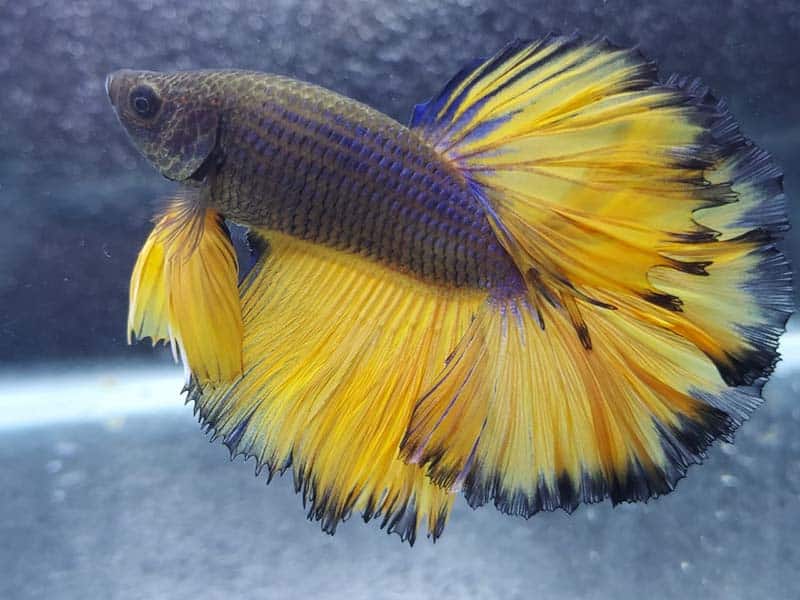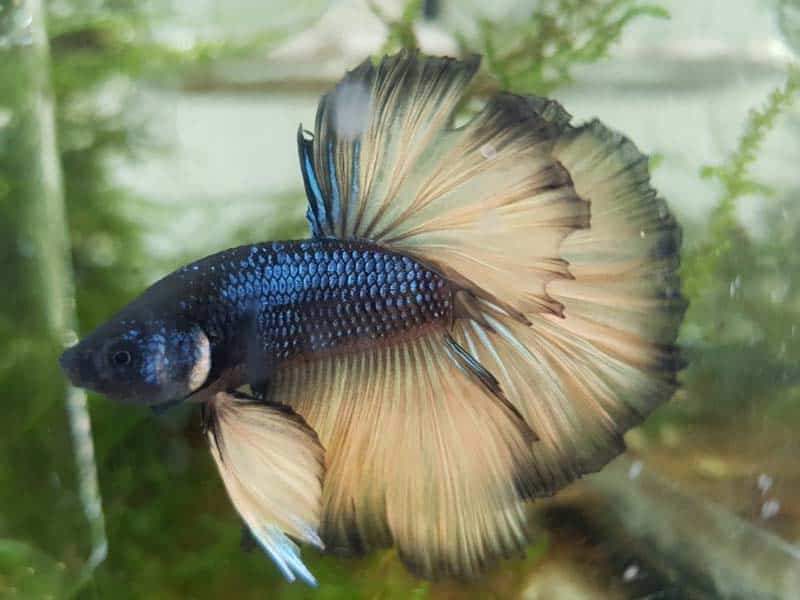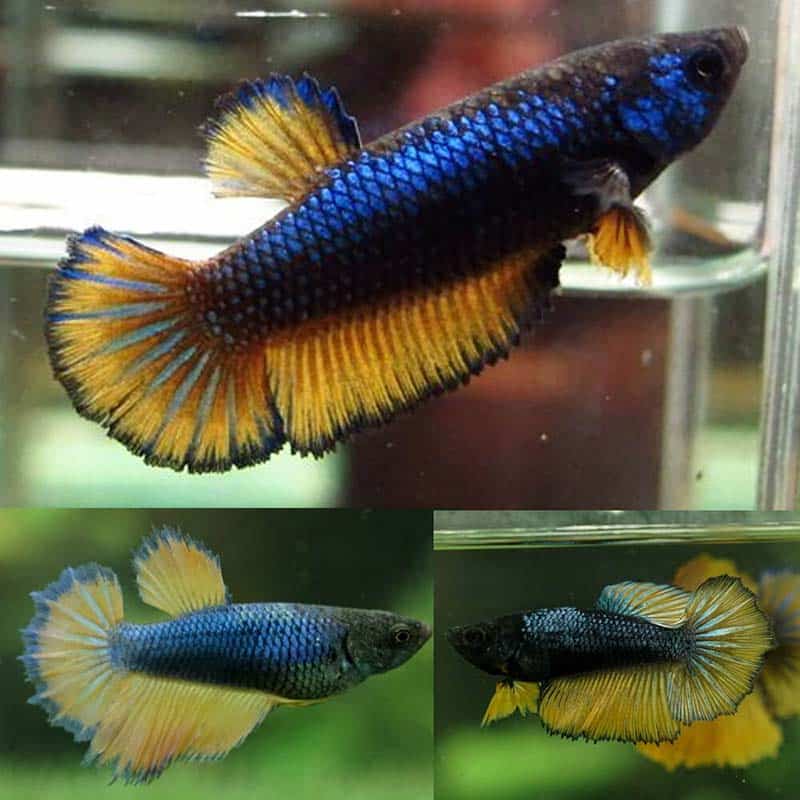If you are looking for a colorful and easy-to-maintain fish for your aquarium, you might want to consider the mustard gas betta. This is a stunning type of betta fish that has a bright yellow or orange color on its fins and tail, contrasted with a dark blue or green body.
The mustard gas betta is a freshwater fish that can live in tropical conditions.It is also a hardy and adaptable fish that can thrive in different water parameters. This makes it a great choice for novice aquarists who want to keep a tropical fish.
In this article, National Park Aquarium will help you learn about the facts, appearance, colors, variations, and beautiful photos of betta fish.
Mustard Gas Betta Facts & Overview
| Common Names | Mustard Gas Betta |
| Scientific Name | Betta splendens |
| Adult Size | Approximately 2.5 inches (6.4 cm) |
| Lifespan | 2 to 4 years |
| Family | Osphronemidae (Gouramis) |
| Origin | Siam, Vietnam, Japan |
| Temperament | Generally peaceful, can be aggressive towards males of the same species |
| Compatibility | Best kept alone or with non-aggressive tank mates |
| Tank Mates | Snails, shrimp, peaceful small fish |
| Minimum Tank Size | 5 gallons (19 liters) or larger |
| Diet | Omnivorous – pellet, flake, frozen, live foods |
| Prey | Insects, larvae, small crustaceans |
| Habitat | Slow-moving waters with vegetation and hiding spots |
| Color | Bi-colored with striking coloration |
| Skin Type | Scales |
| Care Level | Moderate |
| Breeding | Requires specific conditions for successful breeding |
| pH Level | 6.5 – 7.5 |
| Water Hardness | Soft to moderately hard |
| Temperature | 75 – 80°F (24 – 27°C) |
| Favorite Food | Live or frozen small insects and larvae |
Interesting Facts
Mustard gas bettas are captivating bi-colored fish known for their high-grade coloration. These long-finned beauties come in a variety of striking colors, creating a unique and eye-catching blend. It’s fascinating to note that bettas are adapted to living in slow-moving waters with limited oxygen availability. They possess a remarkable organ known as the labyrinth, which functions like a lung, enabling them to extract oxygen from air.

One of the remarkable features of mustard gas bettas is their calm demeanor. They aren’t highly active swimmers, and their long fins may limit their swimming abilities. This characteristic allows them to thrive in nano tanks as small as 5 gallons, making them a great choice for smaller living spaces. Additionally, caring for these bettas is relatively straightforward, as they are not picky eaters, unlike some other betta varieties.
These types of betta fish have a rich history, originating from regions such as Siam, Vietnam, and Japan. For decades, they have been captured and selectively bred, resulting in the development of new species and an array of striking colors by dedicated betta breeders.
The lifespan of a mustard betta is about 3 to 5 years, and its average size is like that of other bettas.
Mustard Gas Betta Appearance, Tails & Color
Mustard gas bettas stand out with their distinctive mustard hue paired with another vivid shade, often blue, red, white, or yellow. Their striking fins can fan out to nearly thrice their body length, giving them an elegant look. Their bodies are slim and streamlined, and they feature a unique upturned mouth – an evolutionary trait for feasting on surface larvae and insect eggs in their natural habitat.
Adding to their charm, the tail may showcase a contrasting outline, such as blue, harmoniously complementing the primary mustard shade. Their eyes are petite and pitch-black, and a noticeable round bulge just beneath the head indicates a satiated stomach.
How to Keep Your Mustard Gas Betta Fish Healthy
The happiness and health of your betta are often a direct reflection of its environment and the care you provide.
- Start with an appropriately sized tank and enrich it with live plants. Avoid using fake plants or painted ornaments, as they can harm your betta’s delicate fins or release toxins from paint residues.
- Betta fish lack eyelids, which makes it crucial to provide them with 8 to 12 hours of complete darkness each day to ensure restful sleep. This uninterrupted rest is vital for their overall health and well-being.
- Choose a diet that is rich in protein. Betta fish cannot process plant-based foods, so avoid algae and certain commercial herbivore feeds. Opt food for betta fish high-quality betta pellets or live and frozen foods like brine shrimp and bloodworms to meet their nutritional needs.
- Every third day, introduce a mirror briefly into the tank. This allows your betta to flare, which is a healthy exercise for their mouth muscles and a natural behavior. However, do not keep the mirror in the tank continuously, as prolonged exposure to their own reflection can cause stress.


How Rare Are Mustard Betta?
Genuinely pure mustard gas bettas, first bred by Jude Al 20 years ago, are extremely rare. These bettas have become nearly extinct in their pure form. Today, the mustard gas bettas we encounter are typically the offspring of a mustard gas male and another female species.
It’s important to note that many bettas advertised as mustard gas on websites or in stores are often merely bi-colored fish with tail colors that resemble the genuine variety.
Conclusion
Mustard gas betta fish are a true gem for aquarium enthusiasts. Their dazzling colors and remarkable fins make them an aesthetic centerpiece. Beyond their appearance, they captivate with their unique personality. Ideal for both novice and seasoned aquarists, these fish thrive with basic care, potentially gracing your tank for up to 4 years. Prioritizing their well-being not only prevents illnesses but also ensures they lead a full, vibrant life.










